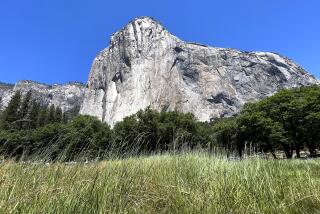No End to Sierra Trail Fight Seen
- Share via
New restrictions on commercial packing trips and backpacking in the Sierra high country may do little to end years of wrangling over the use of some of the most popular wilderness areas in the nation.
A recent U.S. Forest Service decision revised management rules for about 800,000 acres in the John Muir, Ansel Adams and Dinkey Lakes wilderness areas in the Sierra Nevada.
Under regulations being phased in over the next five years, commercial pack operators will be subject to daily trail limits, and some quotas for backpackers will be lowered.
The plan, released April 20, is the latest in years of attempts by the federal government to satisfy the demands of commercial outfitters and private backpackers while ensuring that the rugged high country is not loved to death.
“We feel really good about this decision,” said Inyo National Forest planner Glen Stein. “We think it’s a good compromise and gives us the management tools we believe we ought to have.”
But the initial reaction suggests that the matter is far from settled.
“This plan will not solve anything because everybody has a different opinion and everybody [thinks] he’s right,” said Bobby Tanner, co-owner of Red’s Meadow Pack Station near Mammoth Lakes.
Members of two of three groups that sued the Forest Service last year over commercial pack use expressed disappointment with the new blueprint.
“After 10 years of planning, that is hardly worth the paper it’s written on,” said Tom Suk of the High Sierra Hikers Assn.
The management rules, somewhat modified from a proposal released last year, cover a variety of areas:
* Commercial packers are for the first time subject to daily limits on the number of people they take into the back country. Outfitter growth is limited through caps on the annual number of service days they are allotted.
* Backpacker quotas for some trails are reduced.
* Campfires are banned above certain altitudes.
* Some campsites will be moved to avoid stream damage.
* The number of day hikers allowed up Mt. Whitney will be cut from 150 to 100 a day; the number of overnight backpackers permitted increases from 50 to 60 a day.
Forest Service officials said the trail quotas for the most part maintain current levels of use rather than cutting them, while trying to spread trail use over more days of the week.
The packer rules take away some of the latitude outfitters have enjoyed in running their trips, said Mary Beth Hennessy of the Forest Service. But otherwise, she said, “we think we maintained their businesses at the level they’ve been operating.”
Tanner said he was not familiar enough with the details of the wilderness plan to know precisely how it would affect his business. But packers have generally argued that they have been going through a slow period, so capping their activities will stop needed growth.
The lawsuit against the Forest Service claims that the wild lands are being harmed by high levels of commercial pack use.
The new regulations will not stop that, said Bob Dale of Forest Service Employees for Environmental Ethics, one of the groups that filed the suit.
“Those trail head quotas are so high [for packers] and so flexible that I don’t think it’s going to have much of an impact,” he said.
(BEGIN TEXT OF INFOBOX / INFOGRAPHIC)
Packing It In
The U.S. Forest Service has adopted new restrictions on backpacking and commercial pack operations for more than 800,000 acres within the John Muir, Ansel Adams and Dinkey Lakes federal wilderness areas in the Sierra Nevada.
More to Read
Sign up for Essential California
The most important California stories and recommendations in your inbox every morning.
You may occasionally receive promotional content from the Los Angeles Times.











